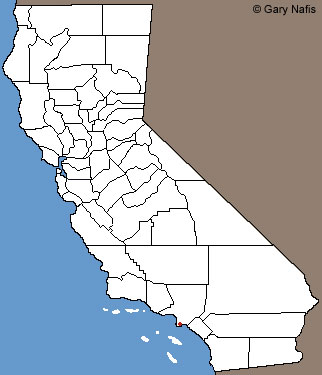 Red dot
Red dot: Location of introduced population in California
|
This species has been introduced into California. It is not a native species.
|
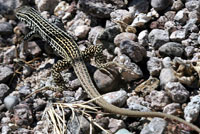 |
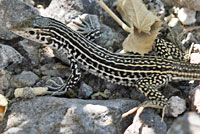 |
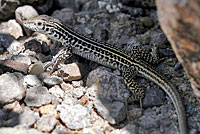 |
| |
Adult, Presidio County, Texas
|
|
I have no pictures yet of this whiptail from the California population.
You can see a picture of one in Hansen and Shedd's 2025 field guide "California Amphibians and Reptiles" on page 347.
|
|
Description |
|
| Size |
Adults grow to about 4.2 inches long from snout to vent (106 mm.)
|
| Appearance |
A medium-size lizard that is large for a whiptail.
The body is long and tubular, with large plate-like scales on the head, small granular scales on the body, and large square scales on the tail and underside. The head is narrow with a pointed snout, the forelimbs are small, and the hind limbs are long. The tail is very long and thin, sometimes twice the length of the body.
The back is marked with 6 to 8 longitudinal stripes with spots and bars that connect to form a checkered appearance.
Stripes are more prominent in juveniles. As adults age, their stripes become broken or disappear.
|
| Life History and Behaviors |
Diurnal
Fast-moving
Forages actively, flicking the tongue and twitching the head and body, and digging prey out of soil and leaf litter
and using claws to dig prey out of dead plants.
Very wary of its environment, but like most whiptails, allows fairly close approach as it forages. |
| Diet |
Insectivores.
Eats grasshoppers, beetles, butterflies, moths in native range, with termites being an important part of the diet.
Diet in California is not known.
Known predators are birds and snakes, especially Coachwhips.
|
| Reproduction and Young |
Asexual.
An all-female (parthenogenetic) species that does not need males for reproduction.
In the native range "Females carry eggs from May to July. They average 3-4 eggs/clutch (range 1-8 eggs/clutch) depending on location. Clutch size has been reported to increase with increasing body size. Hatchlings typically are observed during late July through September." (Randy D. Jennings in Jones, et al. Lizards of the American Southwest, 2009.)
|
| Habitat |
"In its native range, this species occurs in grasslands, plains, desert scrublands, and open woodlands. Introduced populations in CA are associated with urban environments."
(Hansen and Shedd, 2025) "
Often associated with rocky or gravel soils, but also found in sandy areas.
|
| Range |
In California
"Introduced at Long Beach (Los Angeles Co,) just above sea level."
"Reproduction by parthenogenesis has allowed this species, perhaps derived from a single founder, to become established in southern CA."
(Hansen and Shedd, 2025)
So far, as of May, 2025, I have not found any museum records for the species in California and there are no observations for it in California on iNaturalist, the H.E.R.P. database, or on HerpMapper. The only mentions that this species has been introduced into California that I have been able to find so far are in Hansen and Shedd's 2025 California field guide, which does not indicate another source or mention the date of introduction or when it was discovered, and in both the 2025 SSAR Scientific and Standard English Names list and in Emily Taylor's 2025 book California Lizards. Both of these sources cite only the Hansen and Shedd book as their source. A personal communication from Robert Hansen mentioned Greg Pauly with the Los Angeles Natural History Museum as the source of information about the species introduction into Long Beach, though I have not found anything written yet about that yet.
Native Range
"...found throughout Trans-Pecos Texas and adjacent portions of Chihuahua and Coahuila, Mexico. They range north into New Mexico along the Rio Grande and Pecos river valleys ... extends its distribution into northeastern New Mexico, southeastern Colorado, and the panhandles of Oklahoma and north Texas."
(Randy D. Jennings in Jones, et al. Lizards of the American Southwest, 2009.)
|
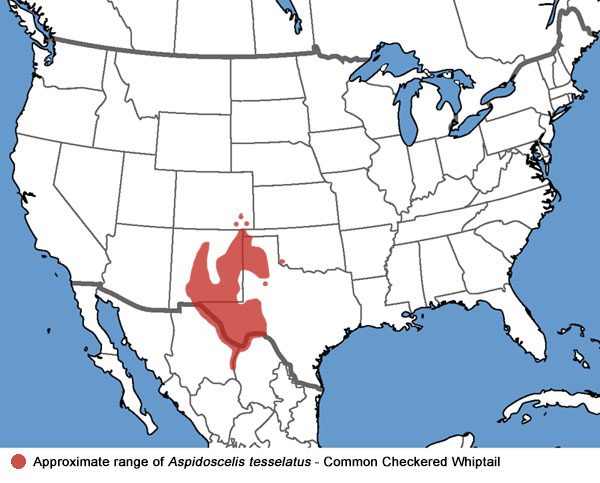 |
| Elevational Range |
Occurs at elevations from 820 to 6561 feet (250 - 2000 meters.)
(Randy D. Jennings in Jones, et al. Lizards of the American Southwest, 2009.)
"Introduced at Long Beach (Los Angeles Co,) just above sea level."
(Hansen and Shedd, 2025)
|
| Taxonomic Notes |
Formerly Aspidoscelis tesselata.
"Tucker et al. (2016, Molecular Phylogenetics and Evolution 103: 75–84) interpreted the gender of the name Aspidoscelis as masculine rather than feminine, and we have therefore changed the endings of several of the names of Aspidoscelis species to their masculine forms..." including A. tesselatus.
(Nicholson, K. E. (ed.). 2025 SSAR Scientific and Standard English Names List)
Relationship to Aspidoscelis dixoni (Scudday, 1973) Gray Checkered Whiptail
"A. dixoni was removed from the 8th edition of this list based on the results of Cordes and Walker (2006, Copeia 2006: 14–26). Hall (2016, Ph.D, dissertation, University Texas at Arlington) corroborated their inference that A. dixoni and A. tesselatus resulted from a single hybridization event based on phylogenetic analysis of whole mt genomes and also found no evidence of differentiation between A. dixoni and A. tesselatus based on population structure analysis of RADseq data."
(Nicholson, K. E. (ed.). 2025 SSAR Scientific and Standard English Names List)
|
| Conservation Issues (Conservation Status) |
| The potential impacts on native species are not known. |
|
Taxonomy |
| Family |
Teiidae |
Whiptails and Racerunners |
Gray, 1827 |
| Genus |
Aspidoscelis |
Whiptails |
Fitzinger, 1843 |
Species
|
tesselatus |
Common Checkered Whiptail |
Say, 1822 |
|
Cnemidophorus tesselatus (Say, 1823) - in James, Long's Exped. Rocky Mts. 1819-1820, Vol. 2, p. 50
from Original Description Citations for the Reptiles and Amphibians of North America © Ellin Beltz
|
Meaning of the Scientific Name
|
Aspidoscelis - Greek - aspido = shield + skelos = leg
tesselatus - Latin - checkered, tiled — refers to the mosaic [checkered] appearance of the adult color pattern.
from Scientific and Common Names of the Reptiles and Amphibians of North America - Explained © Ellin Beltz
|
|
Diploid Checkered Whiptail
Aspidoscelis tesselata
Now includes the formerly-recognized species Aspidoscelis dixoni (Scudday, 1973) Gray Checkered Whiptail
|
Related or Similar California Herps
|
Aspidoscelis hyperythra beldingi - Orange-throated Whiptail
Aspidoscelis tigris stejnegeri - Coastal Whiptail
Aspidoscelis sonorae - Sonoran Spotted Whiptail
|
More Information and References
|
Wickipedia
The Reptile Database
iNaturalist
Hansen, Robert W. and Shedd, Jackson D. California Amphibians and Reptiles. (Princeton Field Guides.) Princeton University Press, 2025.
Nicholson, K. E. (ed.). 2025. Scientific and Standard English Names of Amphibians and Reptiles of North America North of Mexico, with Comments Regarding Confidence in Our Understanding. Ninth Edition. Society for the Study of Amphibians and Reptiles. [SSAR] 87pp.
Samuel M. McGinnis and Robert C. Stebbins. Peterson Field Guide to Western Reptiles & Amphibians. 4th Edition. Houghton Mifflin Harcourt Publishing Company, 2018.
Stebbins, Robert C. A Field Guide to Western Reptiles and Amphibians. 3rd Edition. Houghton Mifflin Company, 2003.
Behler, John L., and F. Wayne King. The Audubon Society Field Guide to North American Reptiles and Amphibians. Alfred A. Knopf, 1992.
Robert Powell, Roger Conant, and Joseph T. Collins. Peterson Field Guide to Reptiles and Amphibians of Eastern and Central North America. Fourth Edition. Houghton Mifflin Harcourt, 2016.
Powell, Robert., Joseph T. Collins, and Errol D. Hooper Jr. A Key to Amphibians and Reptiles of the Continental United States and Canada. The University Press of Kansas, 1998.
Bartlett, R. D. & Patricia P. Bartlett. Guide and Reference to the Turtles and Lizards of Western North America (North of Mexico) and Hawaii. University Press of Florida, 2009.
Jones, Lawrence, Rob Lovich, editors. Lizards of the American Southwest: A Photographic Field Guide. Rio Nuevo Publishers, 2009.
Smith, Hobart M. Handbook of Lizards, Lizards of the United States and of Canada. Cornell University Press, 1946.
Taylor, Emily. California Lizards and How to Find Them. Heyday, Berkeley, California. 2025.
|
|
|
The following conservation status listings for this animal are taken from the July 2025 State of California Special Animals List and the July 2025 Federally Listed Endangered and Threatened Animals of California list (unless indicated otherwise below.) Both lists are produced by multiple agencies every year, and sometimes more than once per year, so the conservation status listing information found below might not be from the most recent lists, but they don't change a great deal from year to year.. To make sure you are seeing the most recent listings, go to this California Department of Fish and Wildlife web page where you can search for and download both lists:
https://www.wildlife.ca.gov/Data/CNDDB/Plants-and-Animals.
A detailed explanation of the meaning of the status listing symbols can be found at the beginning of the two lists. For quick reference, I have included them on my Special Status Information page.
If no status is listed here, the animal is not included on either list. This most likely indicates that there are no serious conservation concerns for the animal. To find out more about an animal's status you can also go to the NatureServe and IUCN websites to check their rankings.
Check the current California Department of Fish and Wildlife sport fishing regulations to find out if this animal can be legally pursued and handled or collected with possession of a current fishing license. You can also look at the summary of the sport fishing regulations as they apply only to reptiles and amphibians that has been made for this website.
|
| Organization |
Status Listing |
Notes |
| NatureServe Global Ranking |
|
|
| NatureServe State Ranking |
|
|
| U.S. Endangered Species Act (ESA) |
None |
|
| California Endangered Species Act (CESA) |
None |
|
| California Department of Fish and Wildlife |
None |
|
| Bureau of Land Management |
None |
|
| USDA Forest Service |
None |
|
| IUCN |
|
|
|
|






